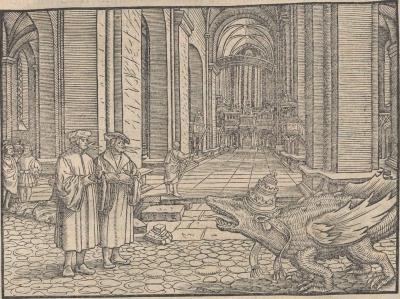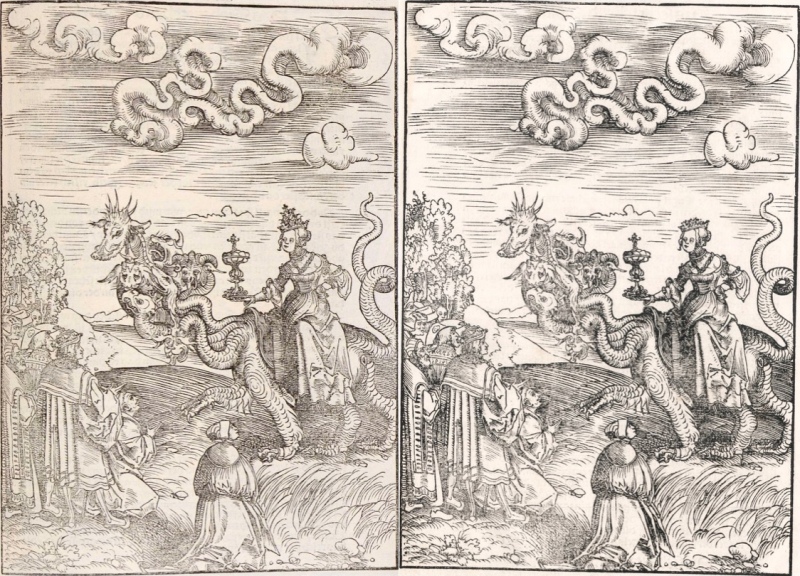The Law and the Gospel

Lucas Cranach the Elder, Allegory of Law and Grace, oil on panel, after 1529; housed in the Germanisches Nationalmuseum, Nuremberg
I am posting this out of order; it was originally intended to be the last post in this series. However, it is fitting to post it on this day commemorating the 500th anniversary of the Lutheran Reformation.
There are any number of treasures or hallmarks of the Reformation that could be highlighted on this day—the three solas, as just one example. But in 1549, three years after Luther’s death, when a young Martin Chemnitz accompanied his relative Georg Sabinus on a trip to Wittenberg and “in a letter written in Greek” asked Philipp Melanchthon “to show [him] a method of properly instituting and shaping the study of theology,” Melanchthon gave a response that bespoke Luther’s lasting influence on him. He “replied that the chief light and best method in theological study was to observe the distinction between the Law and the Gospel.”
If a person could only be given one piece of advice before opening and reading the Bible on his own, this would indeed be the best. There are two main teachings in the Bible, the Law and the Gospel. The Law shows us our sin and how we should live. It shows us that we can never measure up to God on our own, and therefore it threatens, terrifies, and condemns us and thereby prepares us for the Gospel. The Gospel shows us our Savior Jesus and how he has lived and died for us. It showcases God’s gracious promises to us, and so it comforts, assures, and saves us. This distinction is the single greatest aid for reading and understanding the Bible. As the apostle John wrote, “The law was given through Moses; grace and truth came through Jesus Christ” (John 1:17). And if there is one piece of artwork that correctly and beautifully captures that distinction, yes, encapsulates all of the Reformation’s and confessional Lutheranism’s theology, this painting by Cranach is it.
The left half of the painting depicts the Law. The defenseless sinner is driven by death and the devil towards eternal destruction in hell, having been judged guilty by Jesus, enthroned in heaven above as Judge of the world. The man was unable to keep God’s law and earn God’s favor because of original sin, inherited as a result of Adam and Eve’s fall into sin, portrayed in the background. In the foreground on the right, the chief prophet Moses, holding the two tables of God’s law, explains to the other Old Testament prophets that the Law can only condemn and hope must be sought elsewhere. The tree on the right is bare, representing how the Tree of Life is not accessible to fallen mankind by his own powers, or how fallen mankind is spiritually dead and can produce no good fruits (works pleasing to God).
The right half of the painting depicts the Gospel. Jesus is portrayed not as Judge of the world, but as the Savior of the world. John the Baptist points the defenseless sinner to Jesus, the Lamb of God, who takes away the sin of the world (John 1:29) through the atoning sacrifice of his life on behalf of sinners. Through this good news, the Holy Spirit, represented by a dove, instills faith in the sinner’s heart, and thus the sinner receives the benefits of Jesus’ sacrifice; the sinfulness of his heart is covered by Jesus’ blood. The rest of the panel depicts, for the most part, scenes from Jesus’ life. In the background, instead of judging from heaven, he comes down from heaven to share in our humanity and suffer our condemnation in our place (the incarnation in the womb of the virgin Mary). In the foreground, Jesus’ resurrection from the dead is portrayed as the ultimate proof of his victory over death, the skeleton under his left foot, and the devil, the dragon under his right foot. In the upper right hand corner, Jesus ascends into heaven, the nail-marks in his feet still showing. The counterpart to the serpent’s tempting and mankind’s fall into sin in the left half is the prefiguring or foreshadowing of Jesus’ redeeming work through the bronze serpent on the pole (Numbers 21:4-9) in the right half. “Just as Moses lifted up the snake in the desert, so the Son of Man must be lifted up, that everyone who believes in him may have eternal life” (John 3:14,15). The tree in this panel is leafy, representing how the Tree of Life is accessible to fallen mankind through faith in Jesus, or how the one who believes in Jesus has spiritual life and produces good fruits.
What God does in his law demand
And none to him can render
Brings wrath and woe on every hand
For man, the vile offender.
Our flesh has not those pure desires
The spirit of the law requires,
And lost is our condition.
Yet as the law must be fulfilled
Or we must die despairing,
Christ came and has God’s anger stilled,
Our human nature sharing.
He has for us the law obeyed
And thus the Father’s vengeance stayed
Which over us impended.
Since Christ has full atonement made
And brought to us salvation,
Each Christian therefore may be glad
And build on this foundation.
Your grace alone, dear Lord, I plead;
Your death is now my life indeed,
For you have paid my ransom. – Paul Speratus, 1523
Today is an anniversary celebration like none other. Happy Reformation Day, dear readers!
Sources
August L. Graebner, “An Autobiography of Martin Kemnitz” in Theological Quarterly, vol. 3, no. 4 (St. Louis: Concordia Publishing House, October 1899), p. 480
Cranach Digital Archive here and here
Christian Worship: A Lutheran Hymnal (Milwaukee: Northwestern Publishing House, 1993), #390
Quote of the Week – Commands and Promises
Similar Paintings

Hans Holbein the Younger, Allegory on Law and Grace, oil on oak panel, early 1530s; housed in the Scottish National Gallery
Hans Holbein the Younger (c. 1497-1543) was a renowned artist and contemporary and sympathizer of Luther. This painting, clearly influenced by Cranach’s above, is usually titled An Allegory of the Old and New Testaments or even The Old and the New Law, but the painting itself clearly identifies its contrast between the law (lex) and grace (gratia). (The painting correctly shows that both the Old and the New Testaments proclaim grace in Christ.) On the left the two tables of the law are given from heaven to Moses. The law makes us conscious of our sin (peccatum; Romans 3:20; 7:7-13), inherited from Adam as a result of the fall into sin (Romans 5:12-19). The wages of sin is death (mors; Romans 6:23). Nevertheless our justification was foreshadowed (mysterium justificationis) through the bronze serpent erected on the pole (Numbers 21:4-9), and Isaiah the prophet (Esayas propheta) foretold of salvation through the coming Christ (“Behold, a virgin will conceive and bear a son [Ecce virgo concipiet et pariet filium]” – Isaiah 7:14).
At the center of the painting is man (homo). “Wretched man that I am, who will deliver me from this body subject to death [Miser ego homo, quis me eripiet ex hoc corpore morti obnoxio]?” – Romans 7:24.
On the right, John the Baptist (Ioannes Baptista) points sinful man to Jesus, the Lamb of God (Agnus Dei), who takes away the sin of the world (Ecce agnus ille Dei, qui tollit peccatum mundi – John 1:29). His coming down from heaven to take on human flesh in the womb of the virgin Mary is the token of God’s grace. An angel announces Jesus’ birth to the shepherds in the valley below. Jesus as the living bread who came down from heaven (John 6:51) on the right side is the antitype to the bread that was rained down from heaven on the Israelite camp in the wilderness, depicted on the left side (Psalm 78:23-25). As an adult, Jesus is explaining to his disciples that he came to seek and to save what was lost and that he must suffer, die, and rise again in order to do so (Mark 8:31; Luke 19:10). His crucifixion is pictured as our justification or acquittal from sin (justificatio nostra) and his resurrection from the dead as our victory (victoria nostra) over death and the devil (Romans 4:25; 1 Corinthians 15:54-57).

Lucas Cranach the Younger, Middle Panel of the Epitaph Altar for John Frederick the Magnanimous in the Parish Church of St. Peter and Paul in Weimar, oil on lindenwood panel, 1555.
Duke John Frederick I of Saxony commissioned the work to the left a couple years before his death. Lucas Cranach himself died the following year, so the project was taken up and completed by his son. 1 John 1:7; Hebrews 4:16; and John 3:14,15 are printed on the pages of Martin Luther’s open Bible. John the Baptist points to Christ with his finger; Luther points to him with his gaze. Cranach the Elder painted himself in between the two, with Christ’s blood spilling onto his head. (He has made himself the counterpart to “the defenseless sinner” of his earlier painting.) His gaze is directed at the viewer, inviting him or her to worship Christ as Savior with him. The other unique detail is the angel flying in midair in the background over the shepherds, which has a double allusion. The first allusion is to the angel who announced the birth of Christ. This second allusion, indicated by the scroll he holds, is to Revelation 14:6,7. Johannes Bugenhagen, the pastor of the parish church in Wittenberg, preached on those verses for Luther’s funeral and identified Luther as the angel or messenger mentioned there. (Subsequent Lutheran preachers have also not shied away from that identification, though they also apply it to any Christian who faithfully proclaims the gospel.) The words printed on the victory banner borne by the lamb beneath the cross are those of John 1:29. The other details correspond exactly to Cranach’s earlier painting above.








